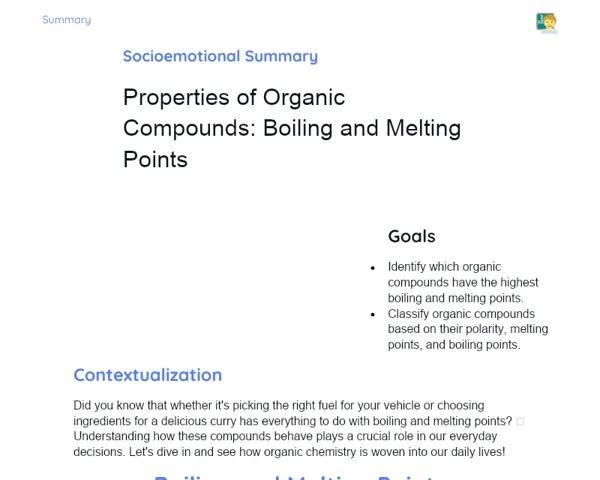Socioemotional Summary Conclusion
Goals
1. Identify and properly use the IUPAC nomenclature for amines.
2. Distinguish the nomenclature of amines from other organic compounds, such as methylamine and ethylamine.
3. Grasp the key properties and characteristics of amines.
Contextualization
Did you know that adrenaline, the hormone that gives us that flutter in our stomachs during exciting or dangerous moments, is actually a biological amine? Understanding amines not only helps us decode the chemistry behind strong emotions but also underscores their significance in medicine and the pharmaceutical industry. Let’s embark on this intriguing journey together!
Exercising Your Knowledge
Definition of Amines
Amines are organic compounds that come from ammonia (NH3), with one or more hydrogen atoms replaced by alkyl or aryl groups. They are fundamental in various sectors, from neurotransmitters in our brain to crucial industrial materials.
-
Amines are categorized as primary, secondary, and tertiary, depending on how many groups are attached to the nitrogen atom.
-
Primary amines have one R (alkyl/aryl) group attached, while secondary amines have two, and tertiary amines have three.
-
The structural adaptability of amines allows them to engage in numerous important chemical reactions.
Classification of Amines
Classifying amines is vital for understanding their interactions and reactions in various chemical scenarios. Being able to identify whether an amine is primary, secondary, or tertiary can aid in predicting its reactivity and role.
-
Primary amines (1st degree) have one alkyl or aryl group connected to the nitrogen. Example: Methylamine (CH3NH2).
-
Secondary amines (2nd degree) have two alkyl or aryl groups bonded to the nitrogen. Example: Dimethylamine ((CH3)2NH).
-
Tertiary amines (3rd degree) have three alkyl or aryl groups linked to the nitrogen. Example: Trimethylamine (N(CH3)3).
-
Classification is key to determining properties such as polarity, boiling point, and solubility of amines.
Properties of Amines
Amines possess distinctive characteristics that influence their solubility, reactivity, and biological functions. A solid understanding of these properties is crucial across fields such as pharmacology and biology.
-
Amines are generally basic and can form hydrogen bonds, affecting their solubility in water.
-
They often emit strong, unpleasant odors.
-
As the number of carbon atoms increases, the solubility of amines in water tends to decrease.
-
Amines play a key role in biological functions, acting as neurotransmitters and vital metabolic intermediates.
Key Terms
-
Amine
-
IUPAC Nomenclature
-
Primary Amines
-
Secondary Amines
-
Tertiary Amines
-
Methylamine
-
Ethylamine
For Reflection
-
How can understanding the nomenclature and properties of amines impact your academic or professional choices?
-
In what ways can comprehending the molecular structure of amines enhance your problem-solving abilities in chemistry and other disciplines?
-
Think back to a challenging experience. How could the emotional management techniques discussed in this lesson assist you in similar situations in the future?
Important Conclusions
-
Amines are organic compounds derived from ammonia, playing an essential role in fields such as biology and pharmacology.
-
They can be classified as primary, secondary, or tertiary based on the number of groups attached to the nitrogen atom.
-
The IUPAC nomenclature of amines is crucial for accurately identifying and distinguishing these compounds.
-
The characteristics of amines, including their basicity and hydrogen-bonding ability, influence their solubility and reactivity.
-
A deep understanding of amines fosters critical skills applicable to chemistry and beyond.
Impacts on Society
Amines significantly affect society, particularly in medicine and the pharmaceutical sector. Neurotransmitters like serotonin and dopamine, which impact our mood and overall well-being, are examples of amines. Studying and grasping these molecules paves the way for developing medications that enhance the quality of life for millions, particularly in managing challenges like depression and mental health disorders.
Moreover, amines are integral to producing various industrial products, including paints, plastics, and cleaning agents. By understanding the chemistry related to these substances, we can innovate safer and more efficient materials, contributing to technological progress and environmental sustainability. This knowledge empowers us to make responsible and eco-friendly choices in our everyday lives, thereby positively influencing society and our environment.
Dealing with Emotions
Let’s try the RULER method at home! Find a calm moment in your day to reflect on how learning about amines made you feel. First, identify your emotions: were you feeling frustrated, curious, or excited? Next, explore why you felt that way. Was it challenging to grasp certain concepts? Did solving a problem give you a sense of satisfaction? Name these emotions clearly. Share these feelings by journaling or discussing them with someone you trust. Lastly, work on managing these emotions by finding strategies that help keep you centred and motivated, like practicing meditation techniques or taking short breaks during your study time.
Study Tips
-
Visualize the nomenclature and structure of amines through mind maps. This method enhances memorization and comprehension of concepts.
-
Form study groups to exchange ideas and tackle problems together. Collaborative learning enriches knowledge and nurtures social skills.
-
Utilize videos and online resources that present the chemistry of amines in an engaging and interactive manner. A variety of learning materials can make study sessions more dynamic and enjoyable.

